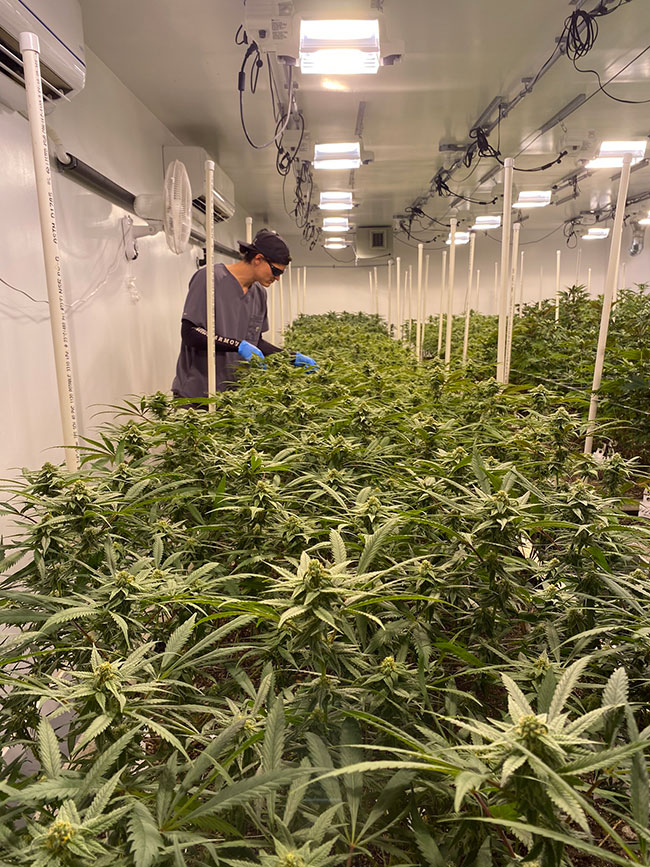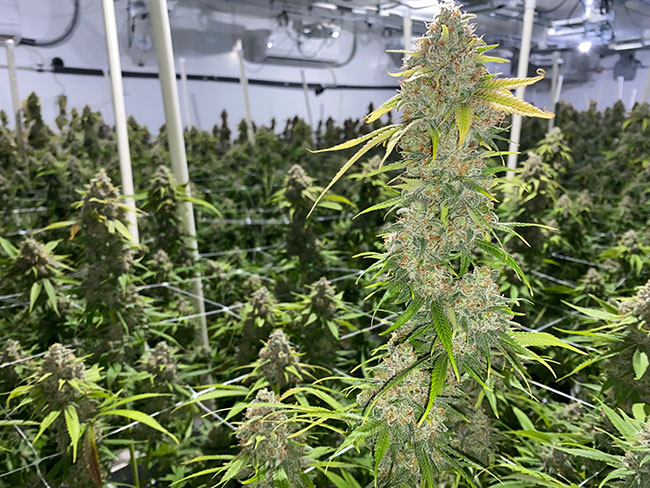
Features
Cultivation
Gerrit Richards wins Top Grower Award
Micro category winner brings passion and precision to micro cultivator Living Cannabis, wielding the alchemy of living soil and a commitment to clean burning products
December 9, 2024 By Haley Nagasaki
 Photo: Beth Talbot
Photo: Beth Talbot Gerrit Richards relates the living soil approach to growing and consuming cannabis as an alchemical progression from “water to fire,” where the same permanent beds have been tended since 2019 means the diverse microbiome requires only water to unlock its soil nutrients for healthy plant uptake. The fire, of course, comes later.
Backing up, born in Calgary and raised between the ages of six and 11 on a 40ft sailboat touching 32 countries and covering 45,000kms, Richards had an unconventional childhood that challenged social norms and profoundly broadened his horizons. Since age three, he has been an insulin-dependent Type 1 diabetic who found relief using cannabis for the management of secondary symptoms such as nausea, appetite, stress and overall mental health.
Richards began growing in 2014 which spurred a deeper scientific interest in plant production and biology, specifically psychoactive plants. Then he went on to complete a Bachelor of Applied Science in Horticulture at the Olds College in Alberta, and pre-legalization worked at Aurora Cannabis in Cremona, Alta.– the first medically licensed facility in the province.
After his first year at Olds, Richards immediately broke into the industry, working weekends while he was in school. He began in the medical side of things and later transitioned to the rec market.
While the micro cultivator Living Cannabis was founded in 2019, Richards worked at the original build of Candre Cannabis, a 45,000 square foot multiple-tiered facility where he spent just under five years doing IPM and genetic development, eventually taking on the role of master grower before moving on to the Okanagan micro in early 2023.
Partner Beth Talbot also began in the legacy market, and later met Richards at Aurora as trimmers “harvesting into each other’s bins,” she says. Talbot moved onto Sundial and Candre, until the pair made the jump to the North Okanagan-based Living Cannabis facility, where she currently works alongside Richards wearing many hats including cultivation tasks, quality assurance, social media management and B2B sales.
Richards’ knack for organic growing is rooted in the principles of permaculture and the pursuit of efficiency after having experienced the waste associated with large scale facilities growing beneath single-use production systems. Having witnessed the closure of facilities due to factors such as overhead, Richards says he saw the writing on the wall. “These systems aren’t really sustainable from an economic, operational or environmental standpoint,” and has aligned himself with what he believes is as a more positive future for the industry with less supply chain dependency and waste.
The founders of Living Cannabis had the foresight in 2019 to use living soil, however until Richards, they lacked the direction from an appropriate operator to produce consistent quality product using a system that worked for their operation.
Since Richards and Talbot came on in early 2023, relocating from their home province of Alberta to the interior of British Columbia with a couple cats and dogs, the producer’s yield has increased substantially, their lots are consistent and they produce clean flowers that do not require microbial remediation or irradiation. They’re also committed to continue developing their own in-house genetic bank, which was already in the works when they arrived, however Richards and Talbot are now actively trialing new phenotypes to bring to market.

NSFW cultivar, grown in organic living soil, nears harvest at micro-LP Living Cannabis in the Okanagan, B.C.
Photo: Beth Talbot
The organic method
Living Cannabis bootstrapped its build and completed its licensing process in-house. The team works with just under their allotted 200m2 canopy spread between three flowering rooms, a veg room and a mothers/genetics room.
“We are optimistic about the proposed changes to increase the micro canopy license from 200m2 to 800m2,” says Richards, “but for now are just focused on the day-to-day.”
He states that with the right operator, he believes the organic methods could be scaled. And with the confidence and the right knowledge, the living soil method is actually quite an easy and low maintenance system to steer. “I water one-to-two times per week as needed,” he says, without ever adjusting the pH. “The soil and plant genetics do most of the hard work, we minerally amend periodically and just do our best to guide plant expression to its full potential.”
The grow team duo are training themselves to work using a different mentality than say a hydroponic grower, “because you’re dealing with nutrients that aren’t immediately available, and you actually have to be working on balancing the soil minerally and microbially.” Genetics also plays into the question of consistency and yield. “We’ve seen massive variability in our system,” says Richards. “The seeds are like siblings. So, we take advantage of the diversity within our seedbank and then find the ones that express the best and have the most desirable characteristics.”
Having the same soil since 2019 means the beds become increasingly microbially rich as the composting organic matter performs nutrient cycling. The high nutrient and moisture holding soil is supplemented with amendments: kelp, humic and fulvic acids, teas, enzymes, as well as cover crops that promote soil biology, root health and nutrient availability.
Interestingly, the mycorrhizal fungi and other amendments help with the observability of soil life under the microscope. Richards learned from soil biologist Elaine Ingham Soil Food Web School where he trained in soil microscopy to identify and study microorganisms in the food web, having since incorporated this training into the regenerative agricultural practices he employs at work.
“We think in terms of availability,” says Richards. “The big thing is the base nutrients are always all there, but we’re trying to make sure they’re available at the right times, and that primarily occurs through soil biology.”
Aside from beneficial predatory insects for IPM, the medium is also teaming with beneficial fungi, bacteria and nematodes. “I fundamentally believe that living soil helps plants express fuller genetic potential and produces a very nice, clean burning product that resonates with consumers.”

The cultivation team at Living Cannabis, Gerrit Richards and Beth Talbot, moved from Alberta to the interior of B.C. to take on their new roles in early 2023.
Photo: Beth Talbot
Spreading the word
Living Cannabis spent the last year selling B2B for a company exporting cannabis to Australia. Domestically their product is available in B.C. and on occasion, Ontario. They’re also focusing on supplying nearby processors and brands, such as Pistol and Paris and Dealr, to expand the supply of products nationally.
In terms of marketing, Talbot says they’ve largely shifted their efforts towards B2B, “because it’s easier for us to sell our product without having to focus on the retail side as much.” They also work with other processors to get their cannabis to market. “A lot of our marketing is consumer targeted in the sense of education about living soil,” she says. “It’s also targeted at business entities who are looking to get organic or eco-conscious cannabis produced using living soil methodologies.”
Talbot finds the old school legacy mentality puts a high emphasis on living soil; they appreciate it. For the novel consumer, she finds it’s more of an ongoing education process as they may not consider the way the plant is produced. Richards adds that all of the desirable secondary metabolite production in cannabis (terpenes, cannabinoids, flavonoids, esters) evolved over millions of years out of soil systems and are inherently linked and synergized by microbiological processes.
Overall, the team is pleased with their current trajectory and the headway gained in the last two years –growing out cultivars like NSFW with its heavy nose, as well as some old school Blueberry crosses. Richards and Talbot are proud of their low impact cultivation style that negates the labour of filling pots, or the environmental impact of disposing rockwool or coco.
Richards says he’s grateful for the differentiation in their business practices, and for the mutual growth shared with Talbot over the past seven years, “working side by side for various employers,” he says, now happy to continue that ongoing journey at Living Cannabis in B.C.
Print this page